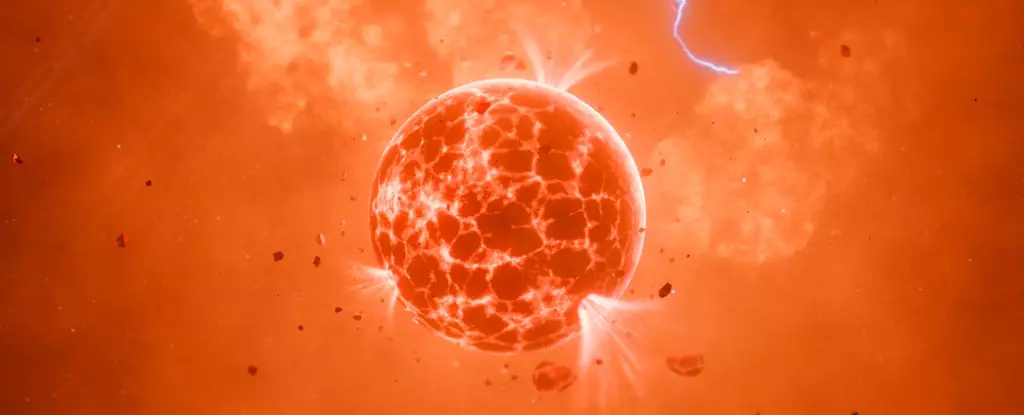In the ever-expanding realm of astronomy, the quest to understand celestial bodies and their dynamic systems has yielded fascinating discoveries. Among the objects of such cosmic scrutiny, exoplanets—planets located outside our solar system—continue to boggle the minds of scientists. Recently, researchers have gathered compelling evidence suggesting that one particular exoplanet, WASP-49b, may have an extraordinary volcanic moon. Located approximately 635 light-years away, this finding sheds light on the potentially diverse arrangements of moons in the Milky Way galaxy, as well as the dynamic processes that govern their evolution.
WASP-49b is classified as a gas giant, sitting within a close orbit of its yellow dwarf star, WASP-49. The exoplanet is approximately 0.37 times the mass of Jupiter and 1.1 times its radius, completing an orbit around its host star every 2.8 days. While gas giants are typically not associated with volcanic activity, the identification of a sodium cloud surrounding WASP-49b has raised eyebrows across the astronomical community. This cloud of sodium has been linked to volcanic processes, potentially originating from an orbiting exomoon.
Astrophysicist Apurva Oza, from the California Institute of Technology, emphasizes that the sodium cloud’s characteristics are incompatible with typical atmospheric behavior of planets. Observations reveal that the cloud appears to move in a direction contrary to the expected motion dictated by gravitational interactions between the exoplanet and its atmosphere. This anomaly strengthens the hypothesis that the sodium is generated by a volcanic exomoon rather than originating from WASP-49b itself.
This groundbreaking claim is situated against the backdrop of an ongoing challenge in exoplanet research—the identification of moons beyond our Solar System. While moons vastly outnumber planets in our cosmic neighborhood, with nearly 300 recognized moons orbiting eight planets, evidentiary findings for exomoons have remained scarce. The intricacies of detecting such smaller celestial bodies yield the need for more advanced methods and techniques.
Initial studies from 2017 indicated the presence of sodium at intriguingly high altitudes within the atmosphere of WASP-49b. By 2019, researchers like Oza were laying the groundwork for their hypothesis regarding the sodium’s origin being linked to a volcanic exomoon. Through advanced spectroscopic techniques performed at the European Southern Observatory’s Very Large Telescope, the team meticulously examined the exoplanet and its surroundings over several nights.
A key factor supporting the exomoon theory lies in the transient nature of the sodium cloud. Observations revealed that the cloud does not have a constant presence, as would be expected from atmospheric processes. Instead, it waxes and wanes, dynamically disappearing behind the exoplanet and star, ultimately ruled out the possibility of it being solely atmospheric.
Computer simulations played a crucial role in corroborating the findings. By modeling the gravitational interactions between the exoplanet and a putative volcanic moon, researchers demonstrated that the observed sodium cloud patterns align best with a moon orbiting WASP-49b every eight hours. This repetitive behavior and the gravitational pull on the moon could plausibly trigger volcanic activity, akin to the phenomena observed on Jupiter’s volcanic moon Io.
Additionally, the proximity of this potential exomoon to its parent gas giant suggests that gravitational forces exerted upon it could initiate significant geological activity, making it an active entity within the WASP-49b system. Such dynamics also raise concerns about the moon’s long-term stability, hinting at a future demise through gradual orbital decay and eventual collision with WASP-49b.
The discovery surrounding WASP-49b and its presumed volcanic moon underscores the complexities surrounding the study of exoplanets and their moons. The surging interest in such celestial bodies not only illuminates the potential existence of robust volcanic activity in unexpected places but also beckons more extensive exploration in the search for exomoons throughout the universe. As researchers continue to refine their methodologies and technologies, the implications of such findings can radically alter our understanding of cosmic evolution, potentially guiding future endeavors in exoplanet research and beyond. The prospect of identifying even more active exomoons presents a thrilling future for astronomers and enthusiasts alike, propelling the quest for knowledge into uncharted cosmic territories.


Leave a Reply